Antioxidants: power against skin cancer. Marc Sorenson, EdD
Antioxidants can quench (eliminate) free radicals.
Antioxidants are popular as supplements, and they are found many foods, but especially in fruits and vegetables. Because they are critical to good nutrition, let’s first consider what they do to a prevent cancer. First of all, what are they? They are substances that eliminate free-radical atoms and molecules. These radicals are formed by combining oxygen with stable atoms, hence the term “oxidation.” Therefore, we must also understand the free radical in order to understand the antioxidant’s importance.
Antioxidants and the notorious free radical 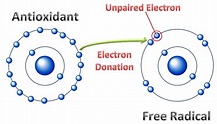
A free radical is a highly unstable atom capable of independent existence and having at least one unpaired electron in its outer shell.[1] So, when an atom loses an electron, it becomes unstable in an attempt to reestablish balance. Because this atom “craves” to have its balance restored, it will “steal” an electron from another atom to achieve stability. Therefore, the atom from which the electron is stolen becomes another free radical. The first atom now becomes stable because it has snatched an electron. Consequently, however, the atom from which the electron is snatched becomes another free radical.
So this process repeats innumerable times.[2] And this chain reaction cannot cease until another substance, with an extra electron to “give away,” steps in. That substance finally furnishes the electron that produces stability. That substance, of course, is an antioxidant. 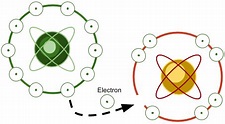 Thus, antioxidants can furnish electrons to stabilize free radicals without causing damage. Hence, they are like the hero who gives his life for the team and then passes on.
Thus, antioxidants can furnish electrons to stabilize free radicals without causing damage. Hence, they are like the hero who gives his life for the team and then passes on.
Oxygen in free-radical formation
As mentioned, the process of free-radical formation is known as oxidation, because free radicals are usually formed due to oxygen molecules, which are unstable. This is possible because oxygen easily combines with other substances. Oxygen gives us life, but its byproducts, if not controlled, can quickly end life. As an iron pipe rusts, it is because it succumbing to the free-radical attack of oxidation. When anything burns, free radicals form. Due to oxidation, a single cigarette creates about one quadrillion free-radical attacks.[3] Cooking creates massive quantities of free radicals. Breathing, heart beat and exercise also create oxidation. It is most noteworthy to understand that without antioxidants, our metabolic processes would shortly kill us because of oxidation.
Antioxidants and skin cancer
Oxidation damages DNA, and unchecked, it causes cancer. Therefore, the fact that smoking kills so many people attests to an obvious reality. Because smokers have insufficient levels of antioxidants to handle the free-radical load, they succumb to cancer. In fact, smoking is a major cause of non-melanoma skin cancers (NMSC); the greater the number of cigarettes smoked, the greater is the risk of skin cancer.[4] So, how important are antioxidants to cancer prevention, especially non-melanoma skin cancer? The research on antioxidants and skin cancer expatiates on this subject.[5]
More important research on antioxidants and Basal Cell Carcinoma (BCC)
The research just mentioned tells us that NMSC accounts for more that half of all diagnoses of cancer. And basal cell skin cancer (BCC) accounts for 70-80% of skin tumors. So, the researchers set out to determine the influence of antioxidants on NMSC. They tested 84 individuals and divided them into two groups: 1. a control group of healthy people, and 2. a case group of those who were undergoing surgery for BCC. In addition, they measured the blood of each group for free-radical markers, and then they compared the two groups. Also, they assessed the usual dietary intake of the subjects. As a result they discovered that the case group had significantly higher markers of oxidative stress compared with controls. While these results were impressive, there were other interesting results:
Other results regarding antioxidants
- Especially relevant was that antioxidants from foods were more pronounced in the control group. It seems like antioxidants from food must have been protective against BCC. Why? Because the intake of foods containing antioxidants showed their influence in reducing oxidative stress. Most of all, vitamins A and E were more prevalent among the non-diseased subjects.
- Also, the dietary concentrations of antioxidants minerals such as zinc, copper and selenium in the case group were significantly lower than healthy controls.
The power of fruits and veggies. 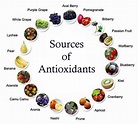
Vegetables and fruits rich in antioxidants are protective against various diseases. We know this due to a plethora of research and observations. This research adds more information indicating that we should stop blaming the sun for skin cancer and clean up our diets. See sunlightinstitute.org for more information on skin cancer and nutrition, And to learn more about the benefits of sunlight, read my book, Embrace the Sun, available at Amazon. https://www.amazon.com/Embrace-Sun-Marc-B-Sorenson/dp/069207600X 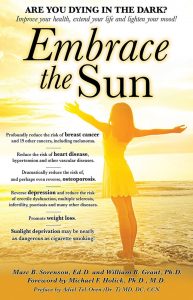
Also, search sunlightinstitute.org: http://sunlightinstitute.org/protect-skin-nutrition-sun-exposure/
Happy sunning!
[1] Karlsson, J. Introduction to nutraology and radical formation. In: Antioxidants and Exercise. Illinois: Human Kinetics Press 1997:1-143. Goldfarb, A. et al. Nutritional antioxidants as therapeutic and preventive modalities in exercise-induced muscle damage. Can. J. Appl. Physiol 1999;24:249-266.
[2] Goldfarb, A. et al. Nutritional antioxidants as therapeutic and preventive modalities in exercise-induced muscle damage. Can. J. Appl. Physiol 1999;24:249-266.
[3] Rahman, I. et al. Role of antioxidants in smoking- induced lung disease. Free Rad Biol Med 1996;21:669-681.
[4] De Hertog, S. et al. Relation between smoking and skin cancer. J Clin Oncol 2001;19:231-238.
[5] Freitas Be, de Castro LL, Aguiar JR, de Araújo CG, Visacri MB, Tuan BT, Pincinato Ede C, Moriel P. Antioxidant capacity total in non melanoma skin cancer and its relationship with food consumption of antioxidant nutrients. Nutr Hosp. 2015 Apr 1;31(4):1682-8.
In an impressive mouse study,[1] it was shown that in animals that were exposed to high doses of radiation during a 35-week program, those that were fed a pre-radiation dose of tomato powder or tangerine powder had a higher level of the antioxidant lycopene than mice who were not fed the powders (control group). Lycopene is a potent antioxidant found in tomatoes, tangerines, watermelon and other fruits and vegetables.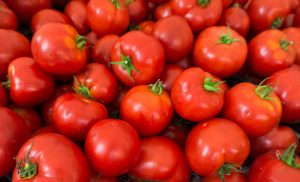
Interestingly, the animals that consumed the tangerine powder had higher levels of lycopene than those consuming the tomato powder, but the results were not as impressive. The number of cancerous tumors that developed in the tomato-fed mice was about half the number that developed in the control group. Tomatoes obviously have anti-skin cancer attributes, but remember that lycopene may not be as effective as the whole tomato powder in reducing that disease. Whole foods are nearly always superior to the nutrients extracted from them, as all of the nutrients work in concert to help health whether for mice or men. There may be hundreds of nutrients besides lycopene in tomatoes, all having a positive effect in protecting against cancer. Why just take one nutrient from the tomato and put it in a pill? I’ll tell you why: It is a way to make money. In this case, the researchers discovered that important substances called glycoalkaloids were significantly higher in the skin after the ingestion of tomato powder, and seem to believe that these substances were responsible for the reduced risk of skin cancer.
It has actually been known for some time that some of the best skin protectants are tomatoes. One investigation showed that among individuals who consumed forty grams of tomato paste daily for ten weeks, sunburn-resistance time increased by 40%,[2] and other research demonstrated that eating different tomato-based products correlated to significantly reduced risk of sunburn after exposure to ultraviolet radiation from sunlamps.[3] It is also known that individuals with the lowest intake of alpha-carotene, beta-carotene, cryptoxanthin, lutein, and lycopene (all carotenoid antioxidants found in such vegetables such as carrots and tomato) had a 50% increased risk for melanoma.[4]
There are several other scientific investigations demonstrating that high fruit and vegetable consumption predict a lesser risk of skin cancer.[5],[6],[7], [8]
There are few foods that taste better than a ripe, field-grown tomato. Eat your fill and enjoy some regular, non-burning sun.
[1] Cooperstone JL, Tober KL, Riedl KM, Teegarden MD, Cichon MJ, Francis DM, Schwartz SJ, Oberyszyn TM. Tomatoes protect against development of UV-induced keratinocyte carcinoma via metabolomic alterations. Sci Rep. 2017 Jul 11;7(1):5106.
[2] Stahl W, Heinrich U, Wiseman S, Eichler O, Sies H, Tronnier H. Dietary Tomato Paste Protects against Ultraviolet Light–Induced Erythema in Humans. J Nutr 2001;131:1449-51.
[3] Aust O, Stahl W, Sies H, Tronnier H, Heinrich U. Supplementation with tomato-based products increases lycopene, phytofluene, and phytoene levels in human serum and protects against UV-light-induced erythema. Int J Vitam Nutr Res 2005;75:54-60.
[4] Millen AE, Tucker MA, Hartge P, Halpern A, Elder DE, Guerry D 4th, Holly EA, Sagebiel RW, Potischman N. Diet and melanoma in a case-control study. Cancer Epidemiol Biomarkers Prev 2004;13:1042-51
[5] Afaq F, Katiyar SK. Polyphenols: skin photoprotection and inhibition of photocarcinogenesis.Mini Rev Med Chem. 2011 Dec;11(14):1200-15.
[6] Afaq F, Katiyar SK. Skin photoprotection by natural polyphenols: Anti-inflammatory, anti-oxidant and DNA repair mechanisms. Arch Dermatol Res 2010;302:71.
[7] Stahl W, Heinrich U, Wiseman S, Eichler O, Sies H, Tronnier H. Dietary Tomato Paste Protects against Ultraviolet Light–Induced Erythema in Humans. J Nutr 2001;131:1449-51.
[8] Meyskens FL Jr, Farmer PJ, Anton-Culver H. Diet and melanoma in a case-control study. Cancer Epidemiol Biomarkers Prev 2004;13:1042-51.
Benefits of sun exposure by Marc Sorenson, EdD…
A new study on nutrition and skin aging corroborates what I have said previously in this blog: Sunlight is not the guilty party when skin problems occur; it is only one of many factors that influence the skin, and in some cases the influence is protective. And of course, sun exposure influence on the other organs of the body is overwhelmingly healthful.
To the extent that sun causes skin damage, it does so due to lack of proper nutrients in the diet, and there is little doubt that there will be some damage caused by sun exposure without proper nutrition. We eat too many toxic fats, too much meat and cheese, too much sugar and too many refined carbohydrates. At the same time we eat far too few vegetables and fruits, which can protect all the tissues in the body, including skin. Much of that protection is due to the high antioxidant levels of fruits and veggies. It is normal for humans to be exposed to sunlight, and it is equally normal for humans to take in the nutrients necessary to prevent skin damage, so that the sun may heal the body without harming our largest organ.
One of those antioxidants is astaxanthin, a new “superstar” in the antioxidant field. A new study shows that a group of mice that were exposed to Ultraviolet A Light (UVA,) lost water in the skin and developed wrinkles (both signs of skin aging).[1] But in a group of mice that were also exposed to UVA and were supplemented with astaxanthin, no such skin aging occurred. This information demonstrates that poor nutritional habits may make sun exposure dangerous to the skin, because it is working without God’s natural balancing through nutrition. Our atrocious eating (and drinking) habits lead to skin damage, and sun exposure gets the blame.
Fruits and vegetable consumption help protect the skin, but other nutritional factors damage the skin. Alcohol consumption is one such factor; in one investigation, those persons who were in the highest quintile (fifth) of alcohol consumption were shown to have a 65% increased risk of melanoma. [2] Another indicated a 250% increased melanoma risk among those who consumed two or more alcoholic drinks per day,[3] and a third demonstrated that those persons who consumed seven or more drinks per week had 64% greater risk of melanoma and a 23% greater risk of non-melanoma skin cancer when compared to non-drinkers.[4] There are at least two other negative dietary habits that correlate to increased skin-cancer risk: first, the highest dairy-product consumption has also been shown to correlate to a 2½ times increased in risk of developing a non-melanoma carcinoma (common skin cancer).[5] Secondly, the types of fats we consume are exceptionally important. Fats we consume in junk foods are deadly, both for overall health and for skin cancer. They are filled with free-radical molecules that wreak havoc on the skin; if we eat such fats without massive quantities of colorful fruits and veggies, we will be much more susceptible to skin damage and potential cancers of all kinds.
Sun exposure is absolutely essential for human health; but to protect yourself against any damage to the skin, eat the foods that were made for humans!
[1] Komatsu T, Sasaki S, Manabe Y, Hirata T, Sugawara T. Preventive effect of dietary astaxanthin on UVA-induced skin photoaging in hairless mice. PLoS One. 2017 Feb 7;12(2):e0171178.
[2] Millen AE, Tucker MA, Hartge P, Halpern A, Elder DE, Guerry D 4th, Holly EA, Sagebiel RW, Potischman N. Diet and melanoma in a case-control study. Cancer Epidemiol Biomarkers Prev. 2004 Jun;13(6):1042-51.
[3]Bain C, Green A, Siskind V, Alexander J, Harvey P. Diet and melanoma. An exploratory case-control study. Ann Epidemiol 1993;3:235-38.
[4]Jessica T. Kubo, Michael T. Henderson, Manisha Desai, Jean Wactawski-Wende, Marcia L. Stefanick, Jean Y. Tang. Alcohol consumption and risk of melanoma and non-melanoma skin cancer in the Women’s Health Initiative. Cancer Causes Control. 2014 Jan;25(1):1-10.
[5]Hughes MC, van der Pols JC, Marks GC, Green AC. Food intake and risk of squamous cell carcinoma of the skin in a community: The Nambour skin cancer cohort study. Int J Cancer 2006; online publication ahead of print.
